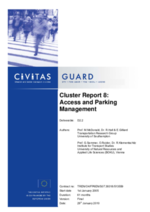Truck parking management
Thematic areas
Urban logistics
Summary
In order to reduce noise pollution and optimise accessibility and safety in areas close to Rotterdam’s port, 60 long-term parking places were designated for heavy goods vehicles.
Implementing sustainable mobility
Prior to measure implementation, residents of urban areas close to one of the city’s port districts suffered from high levels of noise due to heavy goods vehicles parking in residential streets. Many local truck drivers were using the residential streets to park their vehicles over the weekend and the presence of trucks was an obstacle to accessibility and made residents feel unsafe. In order to address these issues, an area was designated as a long-term parking site for trucks.
The new truck park was located in Rotterdam Fruitport, where approximately 80 companies use a harbour dealing for the most part with trade in fruits and concentrated juices. The harbour area is also close to the residential Delfshaven district. The truck park offers secure parking with 24-hour surveillance for trucks and lighter distribution vehicles.
Progress
The truck park project was part of the a large project for the revitalisation of the entire harbour area. The first designs for the truck park were prepared in 1997, and 40 dedicated spaces were created. Under the TELLUS measure, a further 20 spaces were added in 2003 and facilities were improved. Truck parking management was improved via the installation of a traffic guidance system and communication and safety systems. In addition, the local police department were requested to tighten parking controls in the residential areas.
Outcomes
The development of the truck park resulted in less parking in surrounding residential areas. In 2004, well over 9,000 trucks made use of the Fruitport truck park for between one and seven days. Trucks parking for longer than a week are directed to another facility. The occupancy rate is between 50 and 60 percent. The trucks using the park belong to both national and international haulage companies. Truck drivers generally expressed a positive attitude to the park.
The decrease in parking movements in residential areas shifted the peak noise burden from populated to less-populated areas.
Important lessons learned included the need for good communication with truck drivers about the benefits of the new parking facility, the need for clear signposting, and the importance of setting fees at a rate that does not deter drivers from using the truck park.








